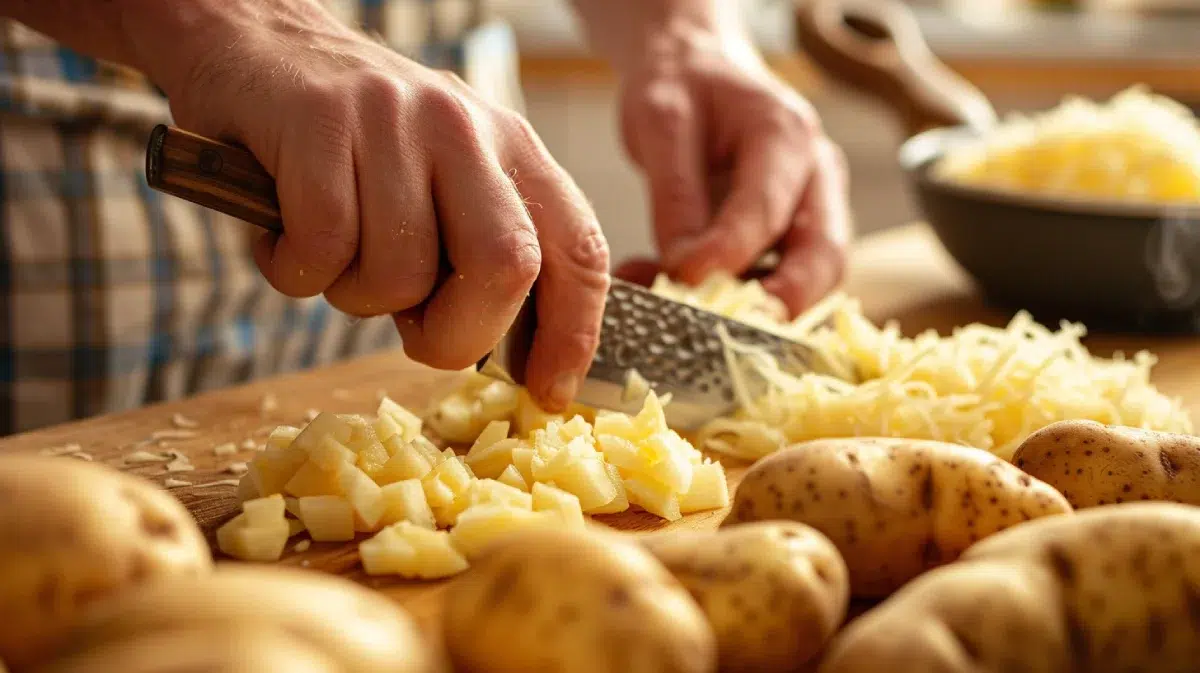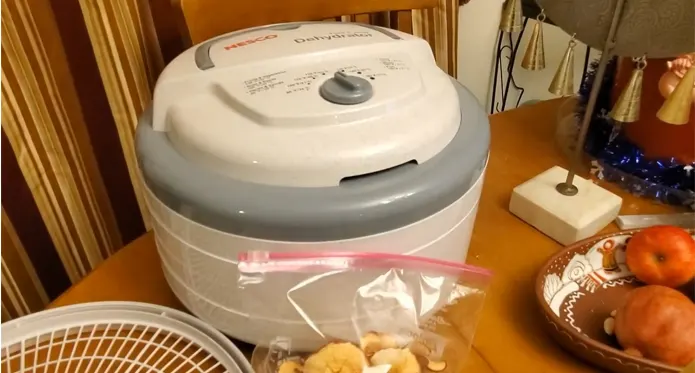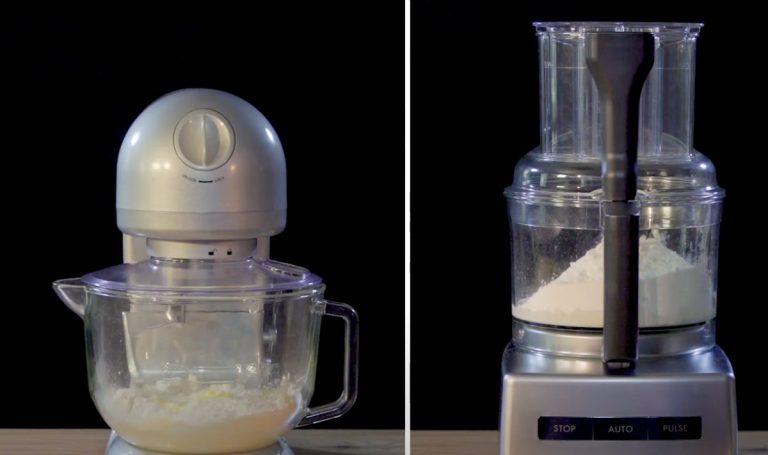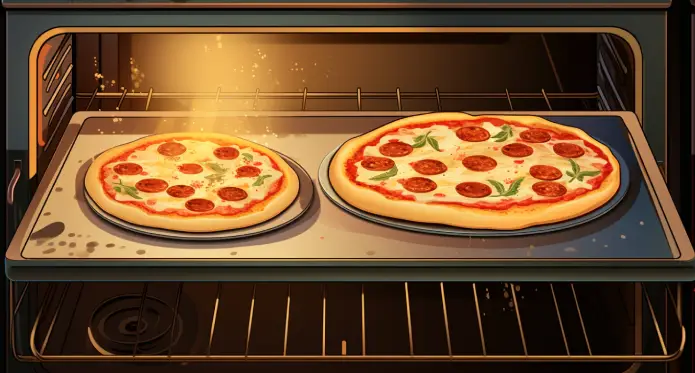How to Grate Potatoes Without a Grater: Innovative Methods
You can efficiently grate potatoes without a traditional grater using several methods. Employ a food processor with a shredding disc and feed the potatoes gradually. Alternatively, use a mandoline for even slices, securing it on a stable surface.
For another option, pulse the potatoes in a mixer with non-stick sprayed blades. If no specialized tools are available, slice potatoes thinly with a sharp knife on a chopping board. You can also create uniform cubes and strips for consistent cooking.
Not only does each method ensure precision, but they also offer versatility for various cooking requirements. With these techniques in mind, explore further to enhance your potato preparation.
Key Takeaways
- Use a food processor with a shredding disc to grate potatoes quickly and efficiently.
- Utilize a mandoline slicer to achieve finely shredded potatoes by sliding them steadily down the blade.
- Pulse peeled potatoes in a mixer with non-stick sprayed blades for an easy grating alternative.
- Slice peeled potatoes thinly with a sharp knife on a chopping board, then stack and chop into fine strips.
- Employ a DIY grater method by soaking, slicing, chopping, and scraping potatoes manually.
Food Processor Method
To efficiently grate potatoes without a traditional grater, you’ll find a food processor to be an essential tool. Start by setting up your food processor with the appropriate shredding disc. Ensure that the machine is securely assembled to avoid any mishaps.
Next, wash and peel your potatoes, making sure they’re free of any dirt or blemishes. Cut the potatoes into manageable pieces that will fit into the food processor’s feed tube. This preparation step is vital for achieving uniform shreds.
Once your potatoes are ready, gradually feed them into the food processor while it’s running. Use the pusher to guide the potatoes towards the shredding disc. The food processor’s powerful motor and sharp blades will quickly and evenly shred the potatoes, saving you significant time and effort compared to manual grating.
Mandoline Technique
A mandoline offers a precise and efficient method to grate potatoes, utilizing various blade options for different shredding needs. With its adjustable thickness settings, you can control the size of the potato shreds to match your specific culinary requirements, whether you’re making hash browns, latkes, or a potato casserole. The versatility of a mandoline makes it an invaluable tool in your kitchen.
To get started, secure the mandoline on a stable surface to guarantee it doesn’t slip during use. Choose the appropriate blade for your desired potato shred size. Most mandolines come with a selection of blades, including straight, julienne, and waffle options. Adjust the thickness setting to your preference, making certain uniformity in each slice.
Safety is paramount when using a mandoline. Always use the provided handguard to protect your fingers from the sharp blades. If your mandoline includes a safety glove, wear it for additional protection. Slide the potato firmly and steadily down the mandoline, allowing the blade to grate it efficiently. Repeat until you’ve processed the entire potato.
A mandoline isn’t just for potatoes; it’s also suitable for other vegetables, making it a versatile addition to your kitchen arsenal.
Using a Mixer
If you don’t have a mandoline on hand, your mixer can also effectively handle the task of grating potatoes with the right attachments. Begin by spraying the mixer blades with non-stick cooking spray. This prevents the potatoes from sticking and guarantees smoother operation. Next, cut the potatoes into smaller pieces so they fit into the mixer and grate evenly.
Make sure you use the correct attachment designed for grating. Place the potato pieces into the mixer and pulse at a low speed. It’s important to pulse in short bursts to avoid over-processing, which can turn your potatoes into mush instead of the desired grated texture.
Here’s a quick comparison to emphasize the steps involved:
| Step | Action |
|---|---|
| Preparation | Spray mixer blades with non-stick cooking spray |
| Potato Cutting | Cut potatoes into smaller pieces |
| Attachment Selection | Use the grating attachment |
| Mixer Operation | Pulse at low speed in short bursts to achieve even grating |
Using a mixer is a convenient and efficient alternative to a traditional grater, allowing you to grate potatoes without the need for additional kitchen tools. By following these steps, you’ll achieve the perfect grated potatoes ready for your recipes.
Knife and Chopping Board
When grating potatoes with a knife and chopping board, mastering slicing techniques is essential to achieve uniform cuts. You’ll need to handle the knife efficiently to guarantee each slice is even, which directly impacts the texture of your dish.
Slicing Techniques Explained
Peeling the potatoes first makes slicing them with a knife and chopping board notably easier and more efficient. Begin by removing the skin using a vegetable peeler or paring knife. Once peeled, position the potato securely on your chopping board. Utilizing a sharp knife, proceed to slice the potato into thin, even pieces.
Make sure your knife is well-honed; a sharp blade reduces the risk of slippage and guarantees clean cuts. As you slice, maintain a consistent thickness to facilitate uniform cooking. For safety, adopt the claw grip technique, tucking your fingers inward to prevent accidental cuts.
After slicing, stack several potato slices into a neat pile. Carefully cut the stack into fine strips, mimicking the texture you’d achieve with a grater. This method, while time-consuming, can be very effective in achieving a grated-like consistency for your potatoes.
Remember to keep your workspace organized and clean to enhance efficiency and safety. Proper knife handling techniques are paramount; always cut away from your body and store the knife safely when not in use. Though more labor-intensive, this method allows you to grate potatoes without needing a specialized tool.
Achieving Uniform Cuts
Achieving even cuts with a knife and chopping board is essential for guaranteeing that your grated potatoes cook evenly and maintain a consistent texture. Begin by slicing the potatoes evenly, which is pivotal for uniformity. Once you have your slices, stack them together to create a compact base. This technique makes it easier to chop the slices into finely grated pieces.
| Step | Description |
|---|---|
| Slicing | Evenly slice the potatoes, focusing on thickness. |
| Stacking | Stack the slices to form a stable base. |
| Chopping | Chop the stack into uniform grated pieces. |
Even cuts are essential because they ensure that each piece of potato cooks at the same rate, preventing some pieces from being overcooked while others remain undercooked. Pay close attention to the thickness of your slices; this will ultimately determine the texture of your grated potatoes.
Although this method may be more time-consuming and labor-intensive compared to using a traditional grater, it allows for precise control over the size and consistency of the potato pieces. With practice, you’ll find that this technique can yield finely grated potatoes suitable for a wide variety of recipes, guaranteeing an even and consistent cook every time.
Efficient Knife Handling
Mastering efficient knife handling is vital for safely and effectively grating potatoes without a traditional grater. Here’s how you can achieve grated potatoes using just a knife and chopping board:
- Use a sharp paring knife: A sharp knife is essential for precise slicing and minimizing effort. A paring knife, in particular, offers control and accuracy, allowing you to make thin, uniform cuts.
- Maintain a steady hand: Stability is key. Make sure your chopping board is secure and your hand movements are deliberate. This minimizes the risk of slips and guarantees consistent slices.
- Slice thinly and uniformly: Begin by slicing the potato into thin, even pieces. Stack these slices and cut them into fine strips. This technique replicates the texture of grated potatoes.
Place your potato on a stable chopping board. With a steady hand, slice the potato into thin, uniform pieces. Carefully stack these slices and cut them into thin strips. This method, while time-consuming, produces satisfactory results for recipes requiring grated potatoes.
Proper technique and patience are crucial to achieving the desired texture. Remember, the quality of your knife and the stability of your chopping board are just as vital as your slicing technique.
Peel and Dice
To begin, use a vegetable peeler to efficiently remove the potato skin, ensuring minimal waste.
Next, dice the peeled potatoes into small, uniform pieces to facilitate consistent slicing.
Maintaining an even size throughout the process is essential for achieving a grated-like texture.
1. Peel Potatoes Efficiently
Efficiently peeling potatoes involves using a vegetable peeler to swiftly remove the skin and any blemishes before proceeding to dice them into smaller, manageable pieces. This initial step is essential for preparing the potatoes for alternative grating methods.
To make sure you peel potatoes efficiently, follow these steps:
- Choose the appropriate vegetable peeler: Opt for a sharp, ergonomic peeler to minimize effort and enhance precision.
- Peel in a uniform motion: Hold the potato firmly and peel from top to bottom or in a circular motion, making sure that you remove both the skin and any blemishes.
- Inspect and touch-up: After peeling, examine the potatoes for any remaining skin or blemishes and use the peeler to touch up those areas.
This method helps in creating a smooth surface, which makes the subsequent dicing process much simpler. By peeling the potatoes effectively, you lay the groundwork for dicing them into uniform pieces, making sure they’re ready for further processing.
Efficient peeling not only saves time but also guarantees that the potatoes are prepared to the highest standard, making the grating process more manageable without a traditional grater.
2. Dice Into Uniform Pieces
Begin by ensuring that your peeled potatoes are ready for dicing into uniform pieces, which is vital for achieving a consistent texture without using a traditional grater.
Start by placing the peeled potato on a cutting board. Using a sharp knife, slice the potato lengthwise into even slices, approximately 1/4-inch thick. This preliminary step is pivotal as it sets the stage for uniform dicing.
Next, stack several potato slices together, holding them firmly to maintain alignment. Carefully cut these stacked slices lengthwise into strips of equal width. Precision is key here; the more uniform your strips, the more consistent your final texture will be. Aim for strips that are again around 1/4-inch wide.
Once you have your strips, rotate them and cut crosswise to produce small, even cubes. These diced pieces should be as uniform as possible to mimic the texture that a grater would create. This method requires careful attention to detail, ensuring that each potato piece is consistently sized.
3. Ensure Consistent Size
Ensuring the uniformity of your diced potatoes is paramount for achieving a consistent texture similar to grated potatoes. Begin by peeling the potatoes meticulously to remove the skin and any blemishes. This not only enhances the potatoes’ flavor but also guarantees a smooth texture.
Dicing the peeled potatoes into uniform sizes is essential for consistent grating. Here’s a detailed process to follow:
- Peel the Potatoes: Use a vegetable peeler to remove the skin and any imperfections, ensuring even texture and taste.
- Dice Evenly: With a sharp knife, dice the potatoes into small, uniform pieces. This guarantees each piece grates evenly.
- Group and Grate: Group the diced potatoes together, making it easier to cut them into grated strips.
Using a sharp knife, cut the grouped diced potatoes into thin strips that resemble the texture of grated potatoes. This method ensures a uniform size, which is crucial for even cooking and flavor distribution.
Consistency in size also affects the potatoes’ taste, as uniformly diced pieces will cook at the same rate, preventing some pieces from becoming overcooked while others remain undercooked. This technique not only substitutes for a grater but also enhances the final dish’s quality and taste.
DIY Grater
For a DIY grater, consider using common kitchen tools like a knife or a fork to achieve finely shredded potatoes. To prepare hash browns, start by soaking raw potatoes in water; this makes them easier to peel and shred. Once peeled, use a sharp knife to slice the potatoes into thin strips. Align these strips and finely chop them into small, consistent pieces.
Alternatively, you can use a fork to scrape the surface of the potato, creating small shreds similar to those produced by a grater.
The key to effective shredding is maintaining a consistent size for even cooking. After shredding, drain excess water to achieve the desired texture. Press the shredded potatoes between paper towels or use a sieve to remove moisture. This step is vital for preventing sogginess, ensuring your hash browns are crispy.
For finer results, you can further chop the shredded potatoes with a knife. This method might be a bit labor-intensive but provides professional-quality results without specialized tools.
Potato Peeler Tools
When you’re prepping potatoes for grating, a high-quality potato peeler can streamline the process by swiftly removing skins and blemishes. Efficient peeling is essential when you don’t have a grater, and choosing the right tool can make all the difference.
Potato peelers come in various designs, each offering unique benefits to guarantee your potatoes are perfectly prepped.
Consider these key features when selecting a potato peeler:
- Design: Y-shaped and straight peelers are the most common. Y-shaped peelers provide better control and are ideal for larger potatoes, while straight peelers offer precision for smaller ones.
- Blade Type: Serrated edges are excellent for tough skins, ensuring smooth peeling without much effort. Swivel blades adjust to the contours of the potato, reducing the risk of waste.
- Durability: Investing in a sturdy, high-quality potato peeler can save you time and frustration. Look for materials like stainless steel that offer longevity and resilience against wear and tear.
Frequently Asked Questions
How Do You Grate Without a Grater?
Did you know that 70% of people find creative kitchen solutions? You can use a knife to finely chop potatoes or a food processor to pulse them to the right consistency. A mandoline with shredding blades works too.
How Do You Hand Grate Potatoes?
To hand grate potatoes, first soak them in water, then peel and remove blemishes. Drain excess water and use a box grater with your preferred hole size. Use a sieve to eliminate extra moisture from the grated potatoes.
What Can I Use to Shred Potatoes?
When the stars align in your kitchen, you can use a food processor, mandoline, or even a trusty knife to shred potatoes. Each tool offers a unique, efficient approach, turning your spuds into culinary masterpieces.
How to Make Hash Browns if You Don’t Have a Grater?
To make hash browns without a grater, peel the potatoes, slice them thinly using a knife or mandoline slicer, then cut into strips. Alternatively, dice them and cook in a skillet until crispy.
Conclusion
So, even without a traditional grater, you’ve got plenty of options to grate potatoes efficiently.
Don’t worry if you’re hesitant about using tools like a food processor or mandoline; with a bit of practice, they’re straightforward and safe.
Leveraging these methods, you’ll achieve the perfect potato texture for any dish.
Remember, mastery comes with practice, so keep experimenting to find what works best for you.







